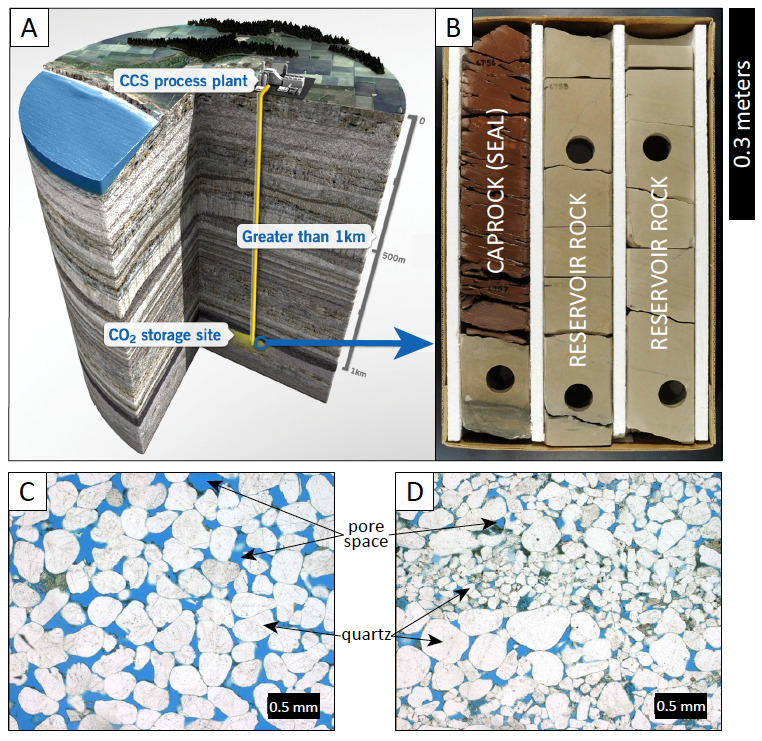CCUS Western States
Utah
Utah is rich in geological diversity and is fortunate to have abundant opportunities available for large-scale CO2 sequestration in the subsurface including 1) the Leadville Limestone and Paradox Formation in the Paradox Basin, 2) the Mesaverde Group in the Uinta Basin and Mesozoic-age sandstone units in the south and east (e.g., the Navajo, Weber, and Entrada Sandstones), 3) the Navajo Sandstone in the northern San Rafael Swell, and 4) the Navajo Sandstone or deeper Kaibab Limestone in the southwest part of the state [1, 2].
As part of CUSP, the Energy & Geoscience Institute (EGI) at the University of Utah and the Utah Geological Survey (UGS) are teaming up to evaluate CO2 sequestration potential across the state and advance detailed characterization projects. EGI and the UGS have led the way on Carbon Capture and Storage (CCS) research and projects in Utah for over 20 years, leveraging each organization’s strengths and sharing technical project tasks related to assessing the potential for geologic CO2 sequestration in Utah. Previous CO2 projects in Utah include CarbonSAFE Rocky Mountains, the Aneth Demonstration, NatCARB and the Southwest Partnership. In addition to being part of CUSP West’s regional assessment efforts, there are two CUSP West Focused projects currently underway in Utah:
- CCUS at the Iron Mountain Iron Mine and Direct Reduced Iron Processing Plant, southern Utah, DOE Award No.: DE-FE0031837 – Phase 1 Completed – This project is a detailed geological assessment of the feasibility of CCUS at the site of a potential direct iron reduction (DIR) processing plant associated with Iron Mountain Mine, west of Cedar City in southwestern Utah, projected to emit upwards of .5 million tons of CO2 annually.
- Downhole Source Tomographic Design for CO2 Plume Detection – This project is investigating the potential for reverse vertical seismic profile technology to monitor the migration of supercritical carbon dioxide plumes underground. A partnership between EGI and Paulsson Inc. of Van Nuys, CA is designing laboratory experiments to test the efficacy of a downhole source tomographic imaging technology for use in carbon sequestration projects.

Figure: Detailed reservoir characterization is being done to assess carbon sequestration potential in Utah. From Szymanski, 2022 (1) with (A) CO2 storage can occur by injecting gas deep underground into rock strata deemed unsuitable for other purposes. Modified from imagery provided by Global CCS Institute (https://www.globalccsinstitute.com/resources/ccs-image-library/). (B) A 4-inch-wide slabbed rock core from the Covenant oil field, Sevier County, Utah. The sandstone (buff-colored) is a good reservoir rock due to its porous and often permeable grains. The mudstone (red) is a good geological seal because it has low permeability and prohibits fluid and gas from escaping upwards. The sharp color contrast indicates the boundary between the seal and reservoir rock. The five holes in the rock core are where plugs were drilled into the rock and removed for analysis. (C) and (D) are photomicrographs of Jurassic-age Navajo Sandstone (reservoir rock) from the Covenant oil field that illustrate pore space availability (blue areas) for CO2 storage between quartz grains (white areas). Images B, C, and D modified from Chidsey and others (2020) (https://doi.org/10.34191/ss-167). Note the significant difference in scale from the well (kilometers) to the core (meters) to the rock grain and pore space (millimeters).
More recently, the UGS and University of Utah have been awarded several U.S. Department of Energy (DOE)-funded cooperative agreements that assess the viability of geological CO2 sequestration in Utah including:
1) Utah Statewide Carbon Storage Assessment: Geological Data Gathering, Analysis, Sharing, and Engagement
The Utah Geological Survey is studying regions in Utah that have the most favorable sites for geologic carbon storage. During this project the UGS will create a report of CCUS potential in Utah, several maps of key reservoir and seal pairs across the state, and provide a ranking of their carbon storage favorability. The final product will be a publicly accessible interactive and interrogatable website application that allows users to visualize and download carbon storage assessments and their associated geological metadata. The project vision is for the website application to serve as a useful tool for the people of Utah to learn more about CCUS in the state.
2) Uinta Basin CarbonSAFE Phase II: The Energy Geoscience Institute (EGI) is leading this project to establish the technical and economic feasibility of a commercial-scale CO2 geological storage complex in the northeast Uinta Basin, Utah, to sequester at least 50 million metric tons of captured CO2 . This project seeks to establish feasibility of commercial storage with high-resolution societal analysis, geological characterization, technical analysis, economic evaluation, and environmental analysis.
3) Red Rocks DAC Hub: The Fervo Energy Company, intends to establish the Red Rocks DAC (direct air capture) Hub in southwest Utah, that will be powered by geothermal energy. Fervo’s geothermal and carbon sequestration exploration and resource characterization activities suggest that there are more than 10 gigawatts of high-quality, economically exploitable geothermal resources available in southwest Utah, which could translate into a storage potential of up to 100 million tons of CO2 annually.
4) Rocky Mountain CarbonSAFE Phase II: The University of Utah intends to assess and establish the feasibility of a commercial large-scale carbon capture and storage commercial hub in central Utah. This initiative encompasses a comprehensive approach, including site-specific characterization, preliminary risk assessment with mitigation plans, detailed planning for subsequent site characterization, technical and economic feasibility assessments, and a Community Benefits Plan. Key methods involve collecting and analyzing geophysical data, drilling, and evaluating a stratigraphic well, developing geologic and computational models for CO2 storage, and engaging with the community to align project objectives with local benefits. The project’s successful execution is anticipated to establish a carbon management hub in central Utah, significantly contributing to the reduction of industrial emissions and atmospheric CO2 levels. By capturing and securely storing CO2 from various industrial sources, the project will provide a model for economic revitalization through sustainable industrial practices. commercial-scale CO2 geological storage complex in the San Rafael Swell.
5) Great Basin CarbonSAFE Phase II: The University of Utah plans to establish the technical and economic feasibility of a commercial large-scale CO2 geologic storage complex in the Basin and Range province of southwestern Utah. This project aims to store more than 50 million metric tons of anthropogenic CO2 sourced from Fervo Energy’s Red Rock Direct Air Capture Hub project and Utah Iron’s new Direct Reduced Iron facility, currently in the design and permitting stage. The project will establish the feasibility of commercial storage through analysis of high-resolution characterization data, technical analysis, economic evaluations, and environmental analysis. The project will accelerate both Fervo Energy’s Red Rocks Direct Air Capture hub implementation and Utah Iron’s goal to be the Nation’s first green iron processing plant, by providing vital site assessment data for the commercial large-scale carbon capture and storage hub.
6) RITAP: The Uinta-Piceance Basin Carbon Management and Community Engagement Partnership: The University of Utah plans to accelerate the equitable and environmentally responsible deployment and development of a storage-based carbon management industry in the Uinta-Piceance Basin in eastern Utah and western Colorado by establishing a partnership with extensive technical, managerial, regulatory, and business expertise specific to carbon transport and storage. The project team will collect and analyze existing data from all available sources to comprehensively evaluate the geologic carbon dioxide storage capacity and potential in the Uinta-Piceance Basin with advanced toolsets. Major activities include partnership development, data gathering, carbon management deployment strategy optimization by considering the unique opportunities and challenges in the Basin, data sharing, technical assistance to community stakeholders, and education resources development for the next generation workforce.
Video Presentation
Home to leading experts in the fields of geology, geophysics, geochemistry, and engineering, the Energy & Geoscience Institute (EGI) at the University of Utah is the world’s largest University based industry cost-shared upstream E&P research program of its kind, with 30+ Corporate Associate members representing 20 countries.
The institute is uniquely positioned to engage high caliber, innovative, and creative geoscience and engineering professionals to expand the body of scientific research and knowledge in the hydrocarbon and geothermal fields for both industry and government projects. EGI staff hail from 15 countries, speak 20+ languages and have a wide range of technical expertise that creates a diversity of thought that fosters cross-discipline solutions and technologies. Carbon Management is a key focus of EGI’s long-term research and development strategy.
The Energy & Minerals Program at the Utah Geological Survey brings together a team of geologists with extensive expertise in reservoir characterization and subsurface assessment. Founded in 1931 the UGS’s mission is to provide timely scientific information about Utah’s geologic environment, resources, and hazards. The UGS Energy & Minerals Program provides the federal, state, and local government, industry, and other organizations with data and other information regarding statewide energy and mineral production and potential. Key contributors: Mr. Michael Vanden Berg – Program Manager, Dr. Eugene Szymanski – Iron Mountain CUSP Focused Project Lead, Dr. Gabriela St. Pierre – CUSP Regional Characterization Lead.
References:
[1] Szymanski, E., 2022, Assessing Geologic Carbon Sequestration Opportunities in Utah. Survey Notes Volume 54, No. 2, Utah Geological Survey, Salt Lake City, Utah, 4 p. https://geology.utah.gov/map-pub/survey-notes/assessing-geologic-carbon-sequestration-opportunities-in-utah/ [2] St. Pierre, G., 2024, Beneath Utah’s Surface: Harnessing Geologic Carbon Storage for a Sustainable Future. Survey Notes Volume 56, No. 3, Utah Geological Survey, Salt Lake City, Utah, 4 p. https://geology.utah.gov/map-pub/survey-notes/beneath-utahs- surface-harnessing-geologic-carbon-storage-for-a-sustainable-future/Contacts:
Prof. Brian McPherson
EGI/University of Utah
423 Wakara Way
Suite 300
Salt Lake City, UT 84108
Phone: 801-585-7961
Email: b.j.mcpherson@utah.edu
Eugene Szymanski, PhD, PG
Utah Geological Survey
1594 W. North Temple
Suite 3110
Salt Lake City, UT 84116
Phone: 801-537-3364
Email: eugenes@utah.gov
Gabriela St. Pierre, PhD, P.G.
Utah Geological Survey
1594 W. North Temple
Suite 3112
Salt Lake City, UT 84116
Phone: 801-538-5410
Email: gstpierre@utah.gov
Publications:
- Smith, K.D., Szymanski, E., Hardwick, C., and Hurlbut, W., 2022, Reducing geologic risk uncertainty for carbon sequestration using modern gravity surveys and modeling in Iron County, Utah, in Proceedings GSA Annual Meeting, Denver, CO (October 2022)
- Szymanski, E., Vanden Berg, M.D., Jagniecki, E.A., Jensen, A., and Moodie, N., 2022, Mitigating Geologic Risk Uncertainty for Carbon (CO2) Sequestration in Multiple Subsurface Targets in the Iron Springs District, Iron County, Utah, in Proceedings AAPG Rocky Mountain Section Annual Meeting, Denver, CO (August 2022)
- Szymanski, E., Vanden Berg. M.D., Moodie, N., Jagniecki, E.A., Hardwick, C., Jensen, A., Hurlbut, W., and Smith, K., 2022, Assessing the Geologic Carbon (CO2) Sequestration Potential of Multiple Subsurface Targets in the Iron Springs District, Iron County, Utah, USA, in Proceedings GSA Cordilleran and Rocky Mountain Joint Section Meeting, Las Vegas, NV; (March 2022)



